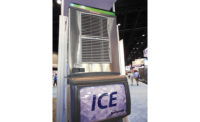What new machine do you recommend? The lineup of products from the ice machine industry changes all the time.
But by making observations and asking the customer specific questions, you will have a better idea of their needs and can match them to current products.
The first step is to gather information on the existing product. Get the brand, find the model number on the nameplate, and write it down. If it’s a modular unit, get the bin model too. Note whether the unit is air-cooled, water-cooled, or remote air-cooled. If it is remote air-cooled, you will need to find the remote condenser and get its model number as well. Take a look at the line routing (length and tubing size). Note the refrigerant type.
Now ask the owner or customer some questions:
If the customer is considering a remote air-cooled model, find out where the condenser can go and how far away the ice machine will be. Most manufacturers have limitations for distance between the machine and condenser.
Also find out how much electrical capacity is available. It would add to the cost to install large amp service to the machine.
If there aren’t any water filters, suggest them, and suggest that they be put in an accessible place. The cartridges will never be changed if they can’t be easily accessed.
If you have access to the Internet, you can probably get product information from the manufacturer’s website. A better source of information is the ice expert at the local distributor.
MEETING THE NEED
Water-cooled models have many advantages. They are quiet, easy-to-install compared to remote air-cooled units, and do not put any excess heat into the room.The trade-off is the cost of water. In many areas, water-cooled machines are not allowed. Check with local authorities.
Self-contained, air-cooled machines are the easiest and cheapest to install, but they do make the most noise and exhaust heat into the surrounding air.
Remote air-cooled units have the low noise advantage of water-cooled units and use no more water than self-contained air-cooled units. But they are more costly to install.
Many ice machines are too small for the application. If an ice machine runs 24 hrs a day, seven days a week without shutting off, it is too small. Not only is it wearing out prematurely, it does not give the user any ice-making margin. The owner may have to go out and buy ice.
THE BEST BIN
Many customers like to recycle their bins. This saves them money. But there are problems with placing new, modular machines on old bins.First of all, the bins were originally designed to go with an ice machine of a certain size, brand, and type. All bins will not work with all ice machines.
Do not specify a machine that is too small, because it may not hold the amount of ice needed. Small bins may also be too low for ease of use.
Having a bin that is too large can also be a problem, as ice that is not used tends to melt together and becomes hard to remove from the bin. (A little cold water poured on it helps to loosen it up.)
One last note about modular machines and bins: When specifying a combination of ice machine and bin or dispenser, be sure that all of the necessary adapter kits are on the list.
TYPES OF ICE
A final complication is the ice type.Flaked ice is best for packing food like fish or chicken. Many supermarkets use it for display.
Nugget ice is good for that as well, and also makes a decent beverage ice.
Cubed ice is fairly universal, good for almost every application. However, cubers do have to stop refrigerating water to release their ice, while flakers don’t.
BRAND NAMES
There are many excellent commercial ice machines on the market. The brand’s reputation should be a factor, as should product and parts availability, design features to suit your application, performance, capacity, electrical consumption, technical support, training, serviceability, and to some degree, price.During the installation, use new tubing, make sure the electrical power is adequate, and don’t forget to vent the drain.
Specifying an ice machine can be as simple as ordering the exact same replacement model, or it can be very involved. Do some checking and give your customers the best ice solution for their needs.
Litchy is service publications manager at Scotsman Ice Systems, Vernon Hills, IL.
Publication date: 03/05/2001


